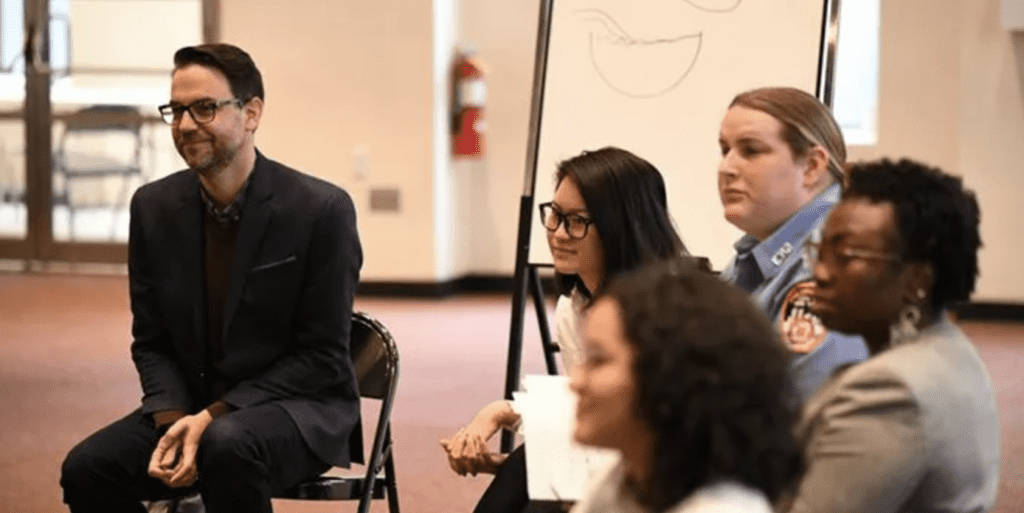At Narativ we’re all about helping you tell your story. There is power in acknowledging where you came from: it keeps you grounded in your purpose, helps people connect with you, and powerfully shares the passion behind what you do.
And today we’re practicing what we preach!
There are key stories that have brought us to where we are today. These moments have instilled lessons that have formed the foundation of who we are and what we do. So, with no further ado, let’s talk about how CEO Jerome Deroy’s story of his journey to Narativ captures a universal need for connection, how powerful personal stories are really the bedrock of Narativ as a whole, and how you can use the Narativ methodology to tell your own personal story.
Striving for Connection: Jerome’s Story
With an education and background in business and finance, Jerome initially found himself working at a French bank in Hong Kong, which he describes as having a large open-desk floor but closed offices for all the executives. After four years of Monday morning meetings with executives who rarely even looked up from their PowerPoint presentations to acknowledge employees, Jerome began searching for new prospects and quit a few months later—much to his boss’s confusion. Though he wasn’t sure what he was going to do, Jerome told the Managing Director it was going to be something “meaningful and creative.”
He moved to New York City with the hope of finding a job in the film world, which is where he met Murray Nossel, PhD, an Oscar®-nominated documentary filmmaker and co-founder of Narativ. While working on a project together, Murray began to tell Jerome all about Narativ’s listening and storytelling methods and how they helped people learn how to talk about who they were and what was important to them.
Murray told Jerome that he believed Narativ had real potential in the business world, which it had not yet branched into, and he wondered if Jerome, with his background in business, could help. Jerome wasn’t sure, but he asked for some examples to help him understand and was sent home with a shoebox full of papers to study.
“I went home that night, opened the shoebox and looked at all these research papers and correspondences, and then a week later I came back with a PowerPoint presentation that said ‘Narativ Business Plan,’” Jerome recalled with a laugh. “Now it’s 2022, and I’m the CEO of Narativ.”
Jerome’s job now is largely to facilitate training to help people express who they are and what they do in a way that is going to engage their audience and create vital human connections—no matter the situation.
Building Connections: Narativ’s Beginnings
Storytelling has been around since the dawn of humanity to help people deliver essential information to each other. In prehistoric times, it fostered connection and aided in survival, evidenced by cave paintings that warn of danger and indicate where to find food. In today’s world, we haven’t lost that natural instinct, and we continue to use stories as a way to make sense of the world around us for ourselves and for others.
“When you tell stories about something, your message is going to stick more, and people are going to remember it more than anything else,” said Jerome.
Narativ’s beginnings show this particularly well: Narativ started as an idea in the mid-’90s when Murray was a social worker serving people with HIV and AIDS. At the time, there were not many effective treatments, so a lot of people were dying, and it created a prevalent feeling of fear and hopelessness in affected communities.
Murray realized that helping his clients tell their stories and then share their stories helped to quell their fear and hopelessness in a huge way. Many sufferers of HIV and AIDS had never been given a voice, and once they had that voice, they began to use it to advocate for themselves—both for better healthcare and for greater understanding from the world at large.
The stories of sufferers became immensely important to humanizing the AIDS epidemic, despite those stories rarely focusing on the virus. Instead, people talked about their lives, their interests, their families, their fears for the future—and all of this helped people who had formerly felt completely removed from the impact of the virus to connect with those who were suffering and see the humanity inside what had formerly seemed like a faceless epidemic.
This foundation of connection is what Narativ is built on. It’s why Jerome was drawn to the company in his own search for meaningful work, and it’s why hundreds of clients have found our methodology worthwhile in achieving their own goals.
It’s because story is powerful.
Telling Your Story: Narativ’s Methodology
Everyone has a story to tell—and whether you’re harnessing a personal story or building an organizational narrative—Narativ’s methodology is rooted in a few key steps we want to highlight for you as you think about identifying and telling your own stories in various contexts.
Create a Listening Environment
“It all begins with listening.” This is a phrase we repeat often when asked about storytelling. Effective storytelling first begins with identifying all the internal narrative and self-criticism keeping you from identifying a story you feel is worth telling. If it helps, write all of those thoughts and obstacles down, and then throw the paper away to symbolically set them aside, diminishing their power over you.
Once you’ve managed that, it will be a lot easier to listen to yourself and those around you, recognizing the points of connection between your life experiences and those of the people you want to connect with.
Find a “Why”
Every story needs a reason to be told. As we like to say at Narativ, “Why Story? Why Now?” Identifying the urgency behind the story and the situation in which it will be told will help to determine the kind of story you choose to tell in a certain situation, as well as how long it should be. Whether you are pitching a product to a prospective customer or you are presenting to a room full of team members, finding the purpose of your story for that situation will help you make great strides in establishing the connection that you’re hoping to make.
Think About the 5 Senses
When actually telling your story, it’s always best to answer the question “what happened?” and use physical sensory details to allow your audience to fill in the emotional aspect for themselves. Painting a picture using the 5 senses allows you to just focus on telling the story, and leaves the door open for your audience to follow along with you.
Practice Your Story
As with any skill, it’s important to practice your story once you have it. Choose someone who you know can listen openly to you and try it out. Let that person know what kind of feedback you’d like to receive. This puts you more in control and less at risk of shutting down in the face of harsh criticism. It’s not time for that yet, especially at the beginning. Feel out what works and what doesn’t, and get a feel for different time limits so that when the time comes to actually tell your story, it has become a natural part of you.
Narativ & You: A Recipe for Connection
Narativ is built on the idea that storytelling is a superpower—no matter what area of life you’re considering. Think about it: a story has far more power to engage people than a list of company values because of the emotion it elicits. Story inspires and connects with our collective humanity in a way that can be deeply felt, creating a ripple effect that reaches far beyond the storyteller. Helping people find and tell those stories is exactly what we’re all about here at Narativ.
Learn more about our service offerings or schedule a brief consult with CEO, Jerome Deroy, to discuss your specific needs.




